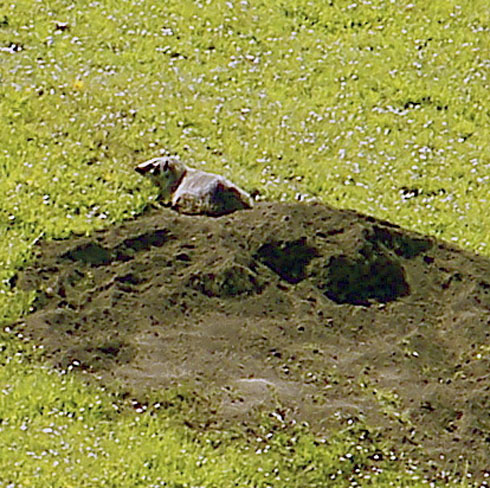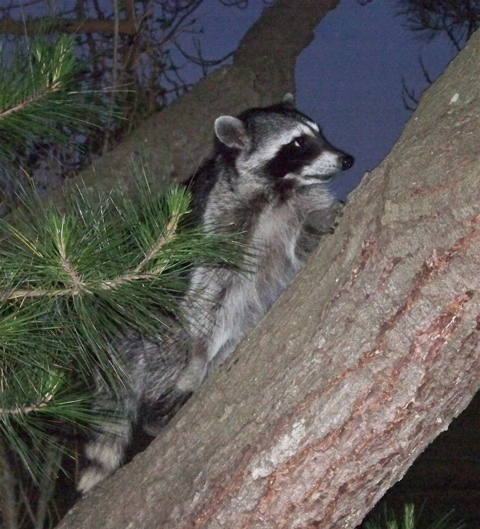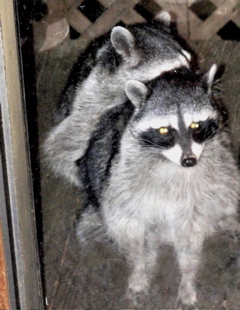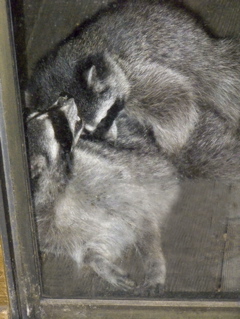Thu 23 Apr 2009
Badger, Ratty, and the sensual raccoon
Posted by DavidMitchell under Photography, West Marin nature, Wildlife
[3] Comments
“Badger hates Society, and invitations, and dinner, and all that sort of thing,” Kenneth Grahame wrote in The Wind in the Willows. “The badger is a wary animal,” concurs Point Reyes Station naturalist Jules Evans in his book The Natural History of the Point Reyes Peninsula.
Badgers dig a “wide, oblong burrow,” Evans notes. The burrows are often easy to locate by mounds of dirt around their entrances. It’s not uncommon for new badger burrows to be excavated overnight in my field or in the Giacomini family’s field next door. A friend once spotted a badger on a mound outside my window, but it scrambled into its burrow before I caught a glimpse of it.

I was naturally envious of my friend, and for more than 10 years since then, I’ve been trying see one of this hill’s badgers for myself. I never managed to do so, however, until this week.
My first glimpse of a badger here occurred Monday when I spotted one about 150 yards away in the Giacomini field. I tried to get a picture of the badger, but that meant zooming my little Kodak’s telephoto to the max. Keeping the telephoto steady while fully extended required using a tripod, and by the time I got mine out, the badger was gone. Tuesday I was better prepared, but this time before I could snap a photo, two deer ran past the burrow, prompting the badger to dart inside.
Around noon Wednesday, I once again spotted the badger sunning itself on its mound, and this time my camera and tripod were ready. I had been thrilled just to finally see the badger, but to also be able to photograph it made my week.
Who knows how long the badger will stick around, but I now feel confident I will see it again. As Badger remarks in The Wind in the Willows, “We are an enduring lot, and we may move out for a time, but we wait, and are patient, and back we come. And so it will ever be.”
 Ratty, as he is called in The Wind in the Willows, showed up on my deck Tuesday to take a drink from the birdbath and eat whatever birdseed he could find.
Ratty, as he is called in The Wind in the Willows, showed up on my deck Tuesday to take a drink from the birdbath and eat whatever birdseed he could find.
Our local roof rats, rattus rattus, are native to southern Asia and are the same rats whose fleas spread the Black Death through Europe in the 1340s, killing off half the population in many places.
Although roof rats can carry murine typhus in the South, in West Marin, the main danger they pose is to dishwashers. You can read all about it at Posting 13. Roof rats can measure a foot long, including their tails, which are longer than their bodies.
Nor were Badger and Ratty the only sightings of Spring on my hill this week. Wild turkeys are back. All week I’ve been able to hear them gobbling, and periodically I’ve seen a tom fanning its tail feathers for three hens. Back after a longer absence, possums have twice visited my deck recently, and on two other occasions, gray foxes have paid calls on me.

About three weeks ago, in fact, I witnessed a confrontation on my deck between two raccoons and a fox. The fox pulled up short when he spotted the raccoons, and when one raccoon growled at it, the fox made a quick departure. Unfortunately, all this happened so fast I didn’t have a chance to even reach for my camera.
 In Spring a young raccoon’s fancy lightly turns to thoughts of love, to paraphrase Tennyson.
In Spring a young raccoon’s fancy lightly turns to thoughts of love, to paraphrase Tennyson.
Indeed on Tuesday evening when I looked out my kitchen door, two young raccoons were making love on my deck.
As is de rigueur among animals other than humans and bonobos, the male raccoon was mounting the female from the rear.
My surprise came when the young male suddenly rolled his mate onto her back, and they continued on face to face.
 Even more of a surprise was that they sometimes appeared to be actually making love.
Even more of a surprise was that they sometimes appeared to be actually making love.
I expected the male to behave more roughly, but these two raccoons were relatively sensual, at times both hugging each other as they rolled around my deck.
I’ve never read much about raccoon passion, which makes me wonder: The Sensual Raccoon, doesn’t that sound like the title of a bestseller?
However, there was — much as I’m loath to acknowledge it — a brazen aspect to the raccoons’ mating. They saw me taking pictures yet they kept right on performing.

Raccoon lust! That should spike traffic to your blog. As an aside: Love the quotes from “Wind in the Willows”, but should point out that “Ratty” was described as a water rat, not a tree rat. And according to Wikipedia, Ratty was actually a European Water Vole (arvicola amphibius), a semi-aquatic mammal that “resembles a rat.”
But don’t let trivia get in the way of a good photo essay. And congratulations on capturing elusive Mr. Badger.
Thank you, Sarah, for your comment. Once again great minds think alike. As it happened, at the very time you were submitting the comment, I was mulling over the distinction between roof rats and water rats and wondering if I should rephrase something to account for it. Ultimately, I reached the same conclusion as you: why let trivia interfere with metaphors drawn from an old story? After all, I told myself, we’re also dealing with two different badgers. Badger in The Wind in the Willows is a European Melinae badger while the critter I photographed is an American badger, Taxidlinae taxus.
How are the horses reacting to the badger? I find it rather odd that the badger scurried away at the approach of deer; badgers are known for being extremely bad-tempered and aggressive. Thus, the phrase “badgering the witness.”
I’d think that the ungulates would give this perpetually annoyed critter a wide berth.